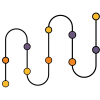Menu
Close

In the data center, it all starts with data collection. We help communities prepare for data collection by setting up the surveys and translations.
Then, once data collection is complete, we process the data and analyze the results. This is where we identify risk and protective factors of adolescents. From there, we work on data visualization and creating reports to provide a practical tool to use in your community.
Once data collection is complete, we provide the reports to communities within a two-month timeframe, so every municipality has relevant and fresh local information to work with.
The Planet Youth data tool was designed to survey youth aged 12-18 years old on risk and protective factors in key community domains (family, school, peer groups, and leisure/out-of-school time activities) in addition to perceptions of substance use.
The data is very important as the key findings drive the localized plans and strategies. The frequency of the survey also allows the local teams to revisit the data and track progress annually or biennially.
If you want to learn more about how we have adjusted surveying during Covid-19, please visit our Covid-19 page. (*link to covid-19 page).
Planet Youth partners receive descriptive reports directed both at the school and community levels. The reports provide immediate feedback and show what youth are experiencing right now in the community.
These data findings are used to monitor risk and protective factors over time, identify relevant risk and protective factors that contribute to rates of substance use, and make strategic decisions tailored to each community.
The following information is included in reports:
During the past 10 years more then 100 peer reviewed articles have
been published about the Icelandic prevention
model’s approach.
We developed an evidence-based approach to adolescent substance use prevention that involved a broad range of relevant stake holders who worked together on this community-based approach.